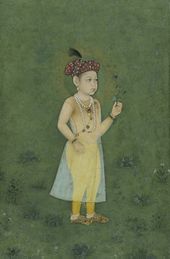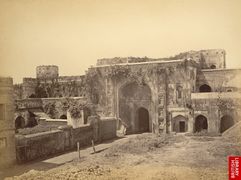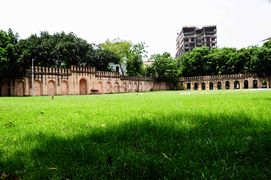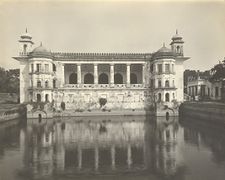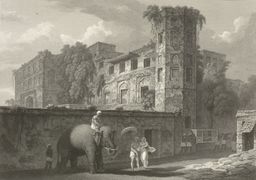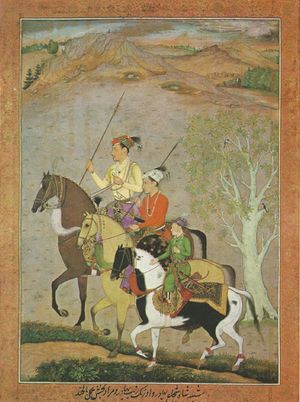شاه شجاع (أمير المغل)
| شاه شجاع | |
|---|---|
| أمير المغل | |
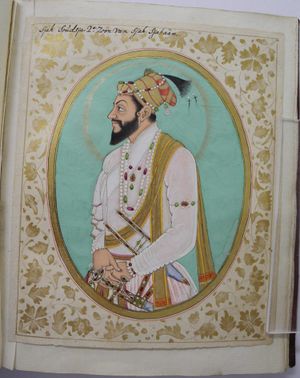 پورتريه شاه شجاع | |
| وُلِد | 23 يونيو 1616 أجمر |
| توفي | غير معروف |
| الزوج | بلقيس بانو بگم پياري بانو بگم زوجة ثالثة |
| الأنجال | ضياء الدين مرزا زين العابدين مرزا بلند أختر مرزا دلپازير بانو بگم گلرخ بانو بگم روشان آرا بگم أمينة بانو بگم |
| البيت | التيمورية |
| الأب | شاه جهان |
| الأم | ممتاز محل |
| الديانة | الإسلام |
شاه شجاع (23 يونيو 1616 - تاريخ الوفاة مجهول)[1] كان ثاني أبناء سلطان المغل شاه جهان والسلطانة ممتاز محل. وكان حاكم البنغال وأوريسا وكانت عاصمته دكا، التي هي الآن في بنگلادش.
النشأة والعائلة
وُلِد شاه شجاع في 23 يونيو 1616، في أجمر. وكان ثاني أبناء وأنجال سلطان المغل شاه جهان وسلطانته ممتاز محل.
حاكم البنغال
شاه زادة محمد شاه شجاع عيـّنه شاه جهان صوبهدار البنغال وبيهار منذ 1641 وعلى أوريسا منذ 25 يوليو 1648 حتى 1661. والده شاه جهان عيّن نائبه الراجپوت أمير ناگپور كونوار راگهاڤ (1616-1671).[1][2] وأثناء حكمه، شيد المقر الرسمي بارا قطرة في العاصمة دكا.[3]
مشاريع العمران في دكا
An etching of Bara Katra by Sir Charles D'Oyly in 1823
حرب خلافة المغل
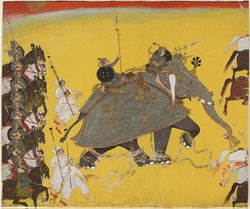
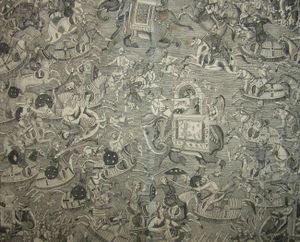
When Shah Jahan fell ill, a struggle for the throne started between his four sons - Dara Shikoh, Shah Shuja, Aurangzeb and Murad Baksh. Shuja immediately crowned himself the emperor and took imperial titles, November 1657.
He marched with a large army, backed by a good number of war-boats in the river Ganges. However, he was beaten by Dara's army in a hotly contested Battle of Bahadurpur near Banares (in modern Uttar Pradesh, India). Shuja turned back to Rajmahal to make further preparations. He signed a treaty with his elder brother Dara, which left him in control of Bengal, Orissa and a large part of Bihar, 17 May 1658.
In the meantime, Aurangzeb defeated Dara twice (at Dharmat and Samugarh), caught him, executed him on a charge of heresy and ascended the throne. Shuja marched again to the capital, this time against Aurangzeb. A battle took place on 5 January 1659 at the Battle of Khajwa (Fatehpur district, Uttar Pradesh, India) where Shuja was defeated.[4]
After his defeat, Shuja retreated towards Bengal. He was pursued by the imperial army under Mir Jumla. Shuja put up a good fight against them. However, he was finally defeated in the last battle in April 1660. After each defeat he had to face desertions in his own army, but he did not lose heart. He, rather, reorganised the army with renewed vigor. But when he was going to be surrounded at Tandah, and when he found that reorganisation of the army was no longer possible, he decided to leave Bengal for good and take shelter in أراكان.
الترقيات العسكرية
- 1636 - 5000(20)
- 1641 - 30,000(25)
- 1646 - 36,000(30)
- 1653 - 40,000(37)
- 1655 - 43,000(39)
اللجوء إلى أراكان
في الطريق إلى أراكان
Shuja left Tandah with his family and retinue in the afternoon of 6 April 1660 and reached Dhaka on 12 April. He left Dhaka on 6 May and boarded the Arakanese ships on 12 May at Bhulua (near present-day Noakhali, بنگلادش).
Shuja first arrived at Chittagong and stayed for some time, from where he took the land route to Arakan which is still called Shuja Road. Thousand palanquins (carriers) carried the harem ladies and Shuja prayed Eid prayer at a place Edgoung (Eidgah) in Dulahzara which is still in Chittagong on the way to Arakan.
Shuja undertook the land journey for 13 days and 13 nights with a troubled mind on the eastern bank of Naf River, half a mile north of Maungdaw town which is still known as Shuja village. Some of Shuja’s retinues there were later retained by the British army as archers army since 1826.
الخيانة في أراكان
Shuja and his entourage arrived at Arakan on August 26, 1660,[5] where they were received by an envoy of Arakan king Sanda Thudhamma and escorted to quarters set aside. Shuja apparently went to Arakan as Sanda Thudhamma promised to provide him ships to take Shuja to Mecca for haj (pilgrimage).
Meanwhile the Mughal emperor had also deposed the ruler of (Hindu) Tripura, Govinda Manikya and enthroned Chhatra Manikya (reigned 1661-66). Govinda who also fled to Arakan, where he met Shuja.[6]
الهرب إلى مانيپور
ولما خان ملك أراكان ساندا ثوداما العهد، فر شجاع عائداً إلى تريپورا، التس سرعان ما أرسل ملكها شجاع إلى إلى مانيپور في 1661 لكي لا يُغضِب قوات أورانگ زيب التي كان يقودها مير جملة الثاني.
أعاد ملك مانيپور خونجاوبا السفارة المكونة من ثلاث رجال إلى بلاط سلطان المغل أورانگ زيب في 1662.[7] وقد اِحتـُفِظ بسفير المغل، نور بگ، في مانيپور بأمر من قاضي مانيپور، محمد ساني. وقد قام بذلك حتى يراه قائدان عسكريان من المغل في طريق انسحابهما، واسماهما دور بگ ورستم بگ فيُخبرا بلاط المغل بوجود شجاع في مانيپور.[8] إلا أن شجاع أُرسِل إلى ربوة أوخرول ببعض المسلمين (كانوا مستقرين بالفعل في مانيپور) كإجراء احترازي من المخبرين المغل. وبذلك لعب ملوك تريپورا ومانيپور أدواراً محورية في انقاذ حياة شاه شجاع وعائلته.
انظر أيضاً
الهامش
- ^ أ ب Abdul Karim. "Shah Shuja". Banglapedia. Retrieved 2013-01-24.
- ^ delhi6
- ^ Ayesha Begum. "Bara Katra". Banglapedia. Retrieved 2013-01-24.
- ^ Battle of Khajwa
- ^ خطأ استشهاد: وسم
<ref>غير صحيح؛ لا نص تم توفيره للمراجع المسماةm1 - ^ Roychoudury, p. 29:(According to traditions in Tripura, Govinda Manikya after losing his throne, fled to Arakan where he met Shah Shuja whom he presented a precious sword and a diamond, and thus friendship was established. It must be in around 1660 that Shuja made way for Tripura).
- ^ A. Hakim Shah, 2008, The Manipur Governance
- ^ Names of Mughal ambassadors can be known from P. Gogoi, 1961, The Tai and Tai Kingdoms who gave دور بگ ورستم؛ Kheiruddin Khullakpam, 1997, Turko-Afghangi Chada Naoda, Lilong: Circles, gives the Boggy clan ancestor as نور بخش الذي لابد أن يكون نور بگ.
للاستزادة
- JN Sarkar (ed), History of Bengal, vol II, Dhaka, 1948
- JN Sarkar, History of Aurangzib, vol II, New Delhi, 1972–74
- A Karim, History of Bengal, Mughal Period, vol II, Rajshahi, 1995
